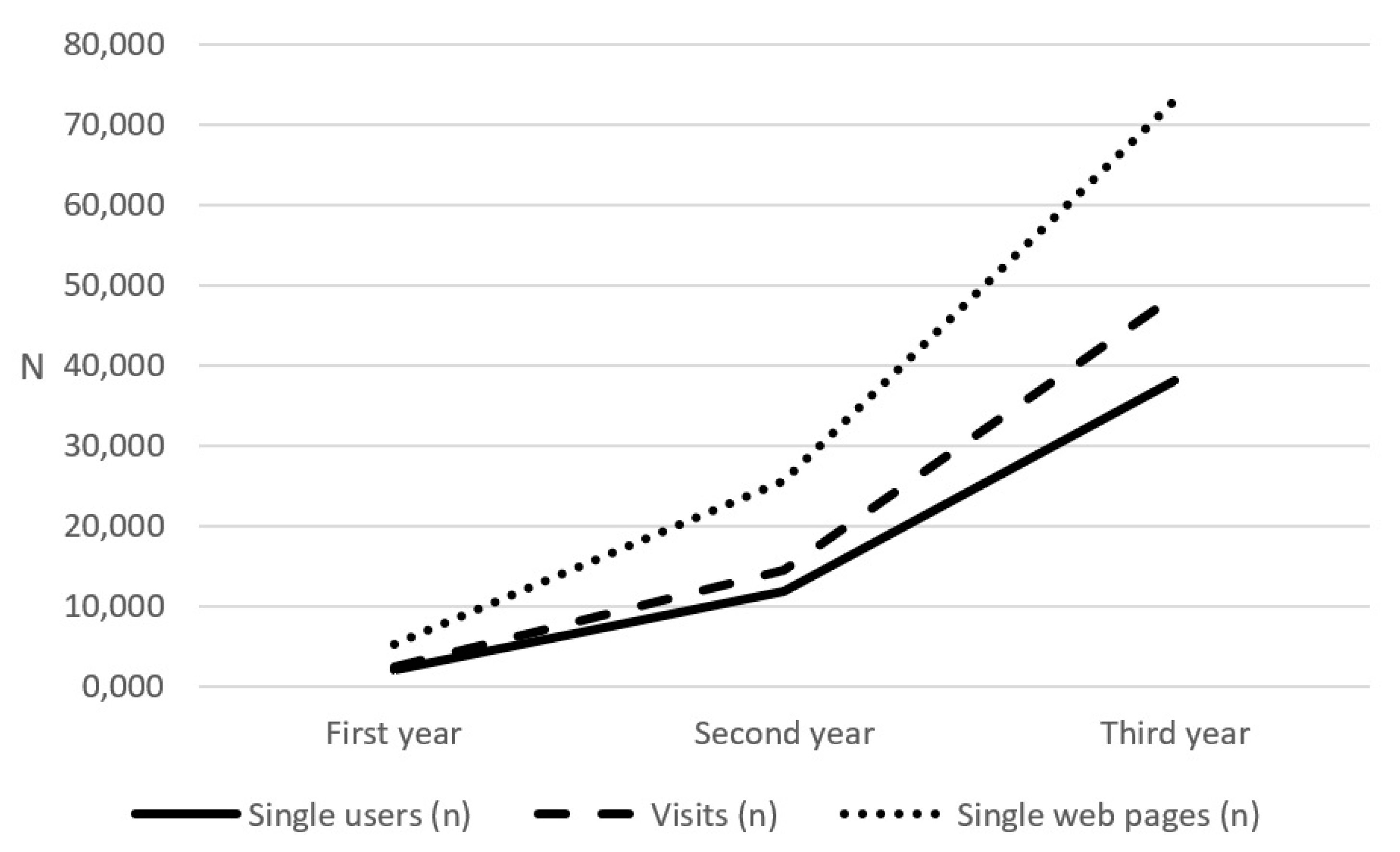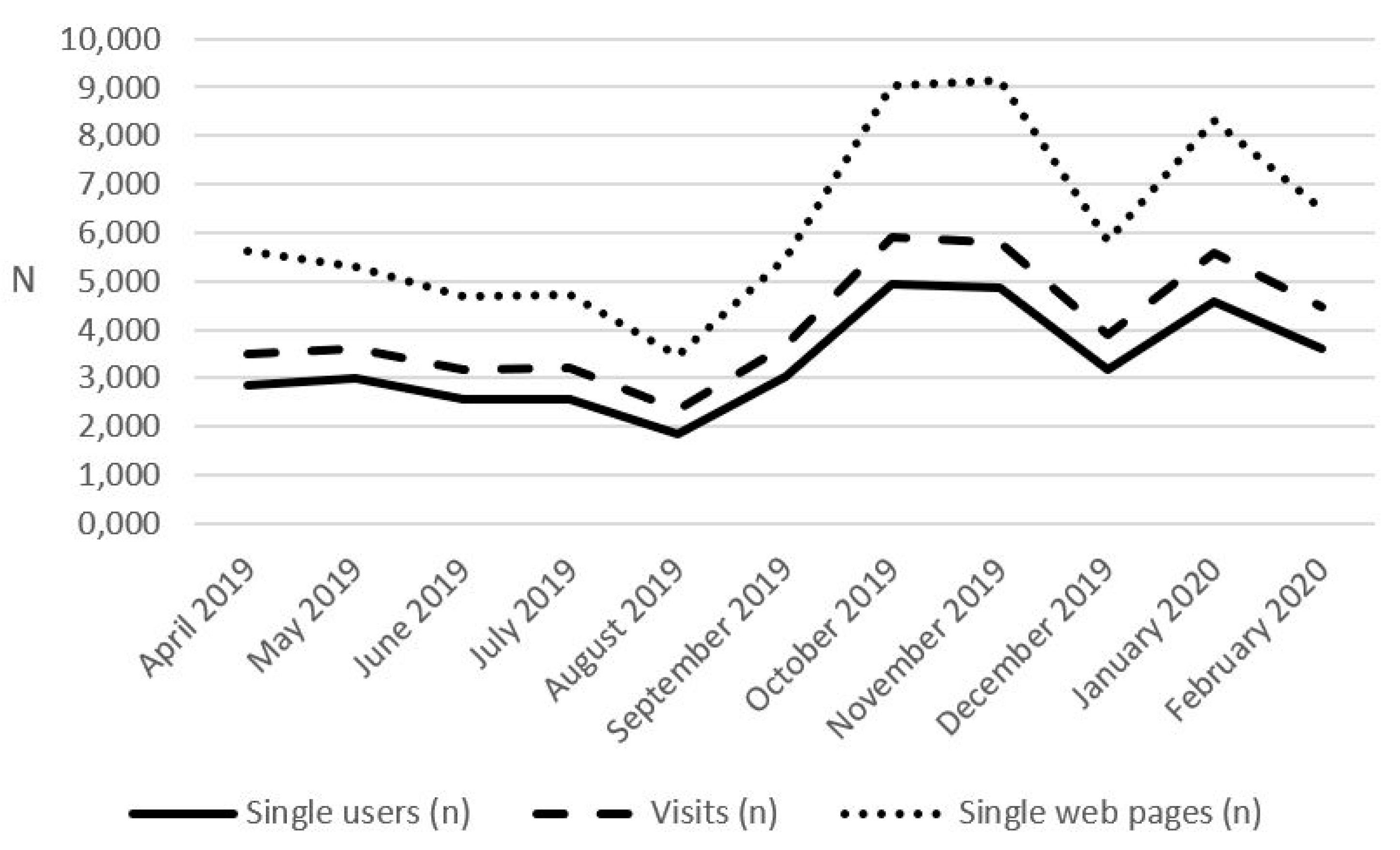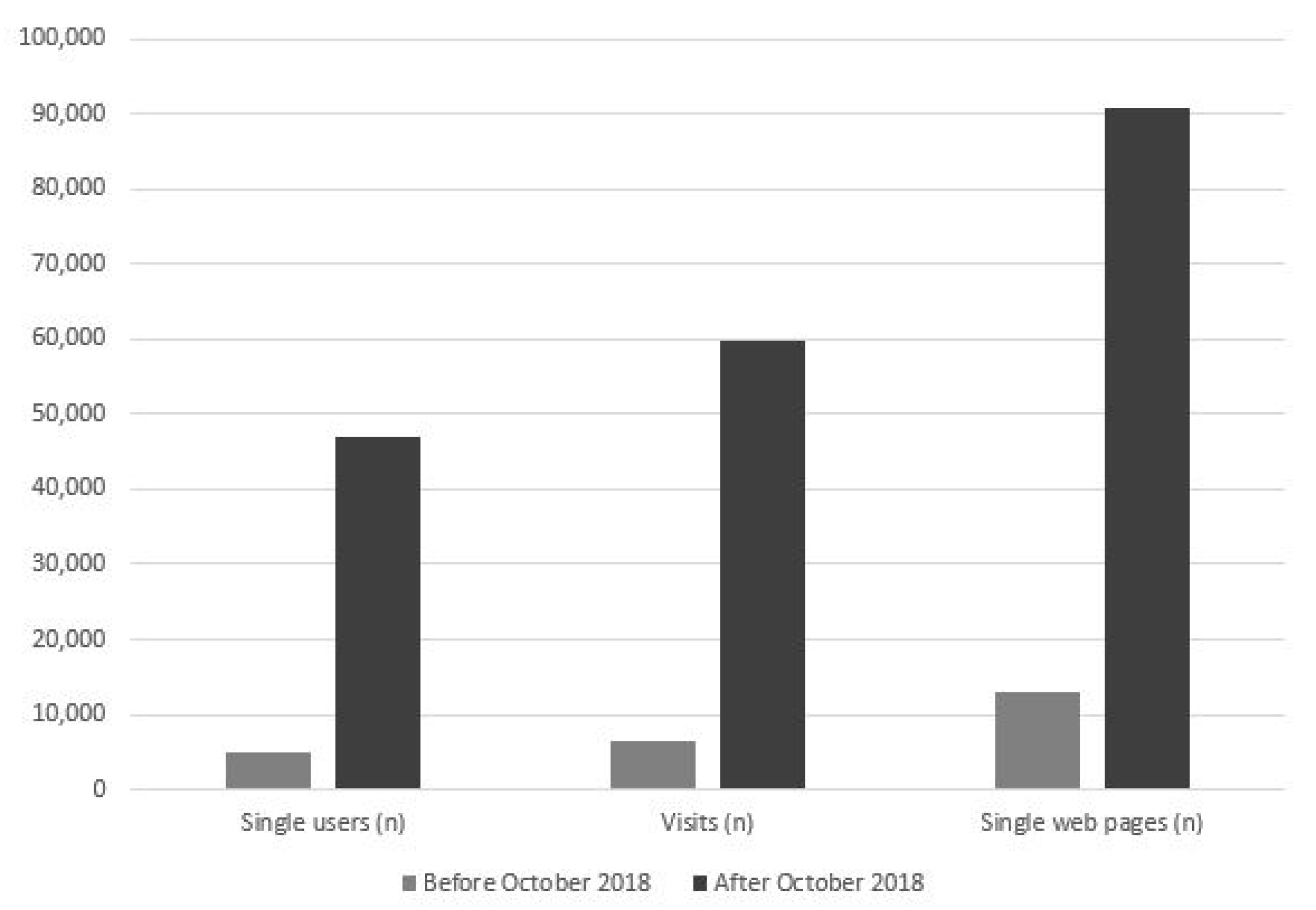The Experience of VaccinarSinToscana Website and the Role of New Media in Promoting Vaccination
Abstract
1. Introduction
2. Materials and Methods
3. Results
3.1. Organizational Staff
3.2. Institutional Patronage and Funding
3.3. VaccinarSinToscana Website Structure and Contents
3.4. VaccinarSinToscana Website and Facebook Account Activities
4. Discussion
5. Conclusions
Author Contributions
Funding
Acknowledgments
Conflicts of Interest
References
- Delany, I.; Rappuoli, R.; De Gregorio, E. Vaccines for the21st century. EMBO Mol. Med. 2014, 6, 708–720. [Google Scholar] [CrossRef] [PubMed]
- Tognotti, E. The eradication of smallpox, a success story for modern medicine and public health: What lessons for the future? J. Infect. Dev. Ctries. 2010, 4, 264–266. [Google Scholar] [CrossRef] [PubMed]
- Volker, V.; Gülhan, D.; Leonard, R.; Friedland, J.K.; Marla, S. Understanding modern-day vaccines: What you need to know. Ann. Med. 2018, 50, 110–120. [Google Scholar] [CrossRef]
- Bonanni, P.; Bonaccorsi, G.; Lorini, C.; Santomauro, F.; Tiscione, E.; Boccalini, S.; Bechini, A. Focusing on the implementation of 21st century vaccines for adults. Vaccine 2018, 36, 5358–5365. [Google Scholar] [CrossRef] [PubMed]
- Bonanni, P.; Ferro, A.; Guerra, R.; Iannazzo, S.; Odone, A.; Pompa, M.G.; Rizzuto, E.; Signorelli, C. Vaccine coverage in Italy and assessment of the 2012–2014 national immunization prevention plan. Epidemiol. Prev. 2015, 4, 146–158. [Google Scholar]
- Larson, H.J.; Cooper, L.Z.; Eskola, J.; Katz, S.L.; Ratzan, S. Addressing the vaccine confidence gap. Lancet 2011, 378, 526–535. [Google Scholar] [CrossRef]
- Dube, E.; Vivion, M.; MacDonald, N.E. Vaccine hesitancy, vaccine refusal and the anti-vaccine movement: Influence, impact and implications. Expert Rev. Vaccines 2015, 14, 99–117. [Google Scholar] [CrossRef] [PubMed]
- Zingg, A.; Siegrist, M. Measuring people’s knowledge about vaccination: Developing a one-dimensional scale. Vaccine 2012, 30, 3771–3777. [Google Scholar] [CrossRef]
- McClure, C.C.; Cataldi, J.R.; O’Leary, S.T. Vaccine hesitancy: Where we are and where we are going. Clin. Ther. 2017, 39, 1550–1562. [Google Scholar] [CrossRef] [PubMed]
- Odone, A.; Fara, G.M.; Giammaco, G.; Blangiardi, F.; Signorelli, C. The future of immunization policies in Italy and in the European Union: The declaration of Erice. Hum. Vaccin. Immunother. 2015, 11, 1268–1271. [Google Scholar] [CrossRef]
- Glanz, J.M.; Wagner, N.M.; Narwaney, K.J.; Kraus, C.R.; Shoup, J.A.; Xu, S.; O’Leary, S.T.; Omer, S.B.; Gleason, K.S.; Daley, M.F. Web-based social media intervention to increase vaccine acceptance: A randomized controlled trial. Pediatrics 2017, 140, e20171117. [Google Scholar] [CrossRef]
- Finnegan, G.; Holt, D.; English, P.M.; Glismann, S.; Thomson, A.; Salisbury, D.M.; Bogaerts, H.; Bonanni, P. Lessons from an online vaccine communication project. Vaccine 2018, 36, 6509–6511. [Google Scholar] [CrossRef] [PubMed]
- Tabacchi, G.; Costantino, C.; Cracchiolo, M.; Ferro, A.; Marchese, V.; Napoli, G.; Palmeri, S.; Raia, D.; Restivo, V.; Siddu, A.; et al. Information sources and knowledge on vaccination in a population from southern Italy: The ESCULAPIO project. Hum. Vaccin. Immunother. 2017, 13, 339–345. [Google Scholar] [CrossRef]
- Ferro, A.; Odone, A.; Siddu, A.; Colucci, M.; Anello, P.; Longone, M.; Marcon, E.; Castiglia, P.; Bonanni, P.; Signorelli, C. Monitoring the web to support vaccine coverage: Results of two years of the portal VaccinarSì. Epidemiol. Prev. 2015, 39, 88–93. [Google Scholar]
- Ferro, A.; Bonanni, P.; Castiglia, P.; Montante, A.; Colucci, M.; Miotto, S.; Siddu, A.; Murrone, L.; Baldo, V. Improving vaccination social marketing by monitoring the web. Ann. Ig. 2014, 26, 54–64. [Google Scholar] [PubMed]
- Vaccinarsi Regionali. Available online: https://www.vaccinarsi.org/connessi/vaccinarsi-regionali (accessed on 31 August 2020).
- We Are Social. Available online: https://wearesocial.com/it/blog/2019/01/digital-in-2019 (accessed on 31 August 2020).
- Kata, A. A postmodern Pandora’s box: Anti-vaccination misinformation on the Internet. Vaccine 2010, 28, 1709–1716. [Google Scholar] [CrossRef]
- Kestenbaum, L.A.; Feemster, K.A. Identifying and addressing vaccine hesitancy. Pediatr. Ann. 2015, 44, 71–75. [Google Scholar] [CrossRef] [PubMed]
- Law n. 3, 11/01/2018. Delega al Governo in materia di sperimentazione clinica di medicinali nonche’ disposizioni per il riordino delle professioni sanitarie e per la dirigenza sanitaria del Ministero della salute (GU Serie Generale n.25 del 31-01-2018). Italy. Available online: https://www.gazzettaufficiale.it/eli/id/2018/1/31/18G00019/sg (accessed on 31 August 2020).
- Ministry of Health. Circular n. 0034074, 21/11/2018. Vaccinazioni raccomandate per le donne in età fertile e in gravidanza. ERRATA CORRIGE. Italy. Available online: https://www.trovanorme.salute.gov.it/norme/renderNormsanPdf?anno=2018&codLeg=66751&parte=1%20&serie=null (accessed on 31 August 2020).
- Ministry of Health. Circular n. 33045, 12/11/2019. Vaccinazioni raccomandate per le donne in età fertile e in gravidanza. Aggiornamento Novembre 2019. Italy. Available online: https://www.trovanorme.salute.gov.it/norme/renderNormsanPdf?anno=2019&codLeg=71540&parte=1%20&serie=null (accessed on 31 August 2020).
- O’Leary, S.T.; Narwaney, K.J.; Wagner, N.M.; Kraus, C.R.; Omer, S.B.; Glanz, J.M. Efficacy of a web-based intervention to increase uptake of maternal vaccines: An RCT. Am. J. Prev. Med. 2019, 57, e125–e133. [Google Scholar] [CrossRef]
- Bechini, A.; Moscadelli, A.; Pieralli, F.; Sartor, G.; Seravalli, V.; Panatto, D.; Amicizia, D.; Bonanni, P.; Boccalini, S. Impact assessment of an education course on vaccinations in a population of pregnant women: A pilot study. J. Prev. Med. Hyg. 2019, 60, E5–E11. [Google Scholar] [PubMed]
- The Health Communicator’s Social Media Toolkit. Available online: http://www.cdc.gov/healthcommunication/ToolsTemplates/SocialMediaToolkit_BM.pdf (accessed on 31 August 2020).
- Panatto, D.; Domnich, A.; Gasparini, R.; Bonanni, P.; Icardi, G.; Amicizia, D.; Arata, L.; Bragazzi, N.L.; Signori, A.; Landa, P.; et al. Development and preliminary data on the use of a mobile app specifically designed to increase community awareness of invasive pneumococcal disease and its prevention. Hum. Vaccin. Immunother. 2016, 12, 1080–1084. [Google Scholar] [CrossRef]
- Panatto, D.; Domnich, A.; Gasparini, R.; Bonanni, P.; Icardi, G.; Amicizia, D.; Arata, L.; Carozzo, S.; Signori, A.; Bechini, A.; et al. An eHealth project on invasive pneumococcal disease: Comprehensive evaluation of a promotional campaign. J. Med. Internet Res. 2016, 18, 316. [Google Scholar] [CrossRef] [PubMed]
- Marar, D.S.; Al-Madaney, M.M.; Almousawi, F.H. Health information on social media. Perceptions, attitudes, and practices of patients and their companions. Saudi Med. J. 2019, 40, 1294–1298. [Google Scholar] [CrossRef]
- Costantino, C.; Caracci, F.; Brandi, M.; Bono, S.E.; Ferro, A.; Sannasardo, C.E.; Scarpitta, F.; Siddu, A.; Vella, C.; Ventrua, G.; et al. Determinants of vaccine hesitancy and effectiveness of vaccination counseling interventions among a sample of the general population in Palermo, Italy. Hum. Vaccin. Immunother. 2020, 18, 1–7. [Google Scholar] [CrossRef]
- Jung, M. Challenges of vaccinations in the era of new media communication. Health Care Manag. 2018, 37, 142–146. [Google Scholar] [CrossRef]
- MacDonald, N.E.; SAGE Working Group on Vaccine Hesitancy. Vaccine hesitancy: Definition, scope and determinants. Vaccine 2015, 33, 4161–4164. [Google Scholar] [CrossRef] [PubMed]
- Odone, A.; Ferrari, A.; Spagnoli, F.; Visciarelli, S.; Shefer, A.; Pasquarella, C.; Signorelli, C. Effectiveness of interventions that apply new media to improve vaccine uptake and vaccine coverage. Hum. Vaccin. Immunother. 2015, 11, 72–82. [Google Scholar] [CrossRef]



Publisher’s Note: MDPI stays neutral with regard to jurisdictional claims in published maps and institutional affiliations. |
© 2020 by the authors. Licensee MDPI, Basel, Switzerland. This article is an open access article distributed under the terms and conditions of the Creative Commons Attribution (CC BY) license (http://creativecommons.org/licenses/by/4.0/).
Share and Cite
Boccalini, S.; Bonanni, P.; Chiesi, F.; Pisa, G.D.; Furlan, F.; Giammarco, B.; Zanella, B.; Mandò Tacconi, F.; Bechini, A. The Experience of VaccinarSinToscana Website and the Role of New Media in Promoting Vaccination. Vaccines 2020, 8, 644. https://doi.org/10.3390/vaccines8040644
Boccalini S, Bonanni P, Chiesi F, Pisa GD, Furlan F, Giammarco B, Zanella B, Mandò Tacconi F, Bechini A. The Experience of VaccinarSinToscana Website and the Role of New Media in Promoting Vaccination. Vaccines. 2020; 8(4):644. https://doi.org/10.3390/vaccines8040644
Chicago/Turabian StyleBoccalini, Sara, Paolo Bonanni, Fabrizio Chiesi, Giulia Di Pisa, Federica Furlan, Barbara Giammarco, Beatrice Zanella, Francesco Mandò Tacconi, and Angela Bechini. 2020. "The Experience of VaccinarSinToscana Website and the Role of New Media in Promoting Vaccination" Vaccines 8, no. 4: 644. https://doi.org/10.3390/vaccines8040644
APA StyleBoccalini, S., Bonanni, P., Chiesi, F., Pisa, G. D., Furlan, F., Giammarco, B., Zanella, B., Mandò Tacconi, F., & Bechini, A. (2020). The Experience of VaccinarSinToscana Website and the Role of New Media in Promoting Vaccination. Vaccines, 8(4), 644. https://doi.org/10.3390/vaccines8040644





